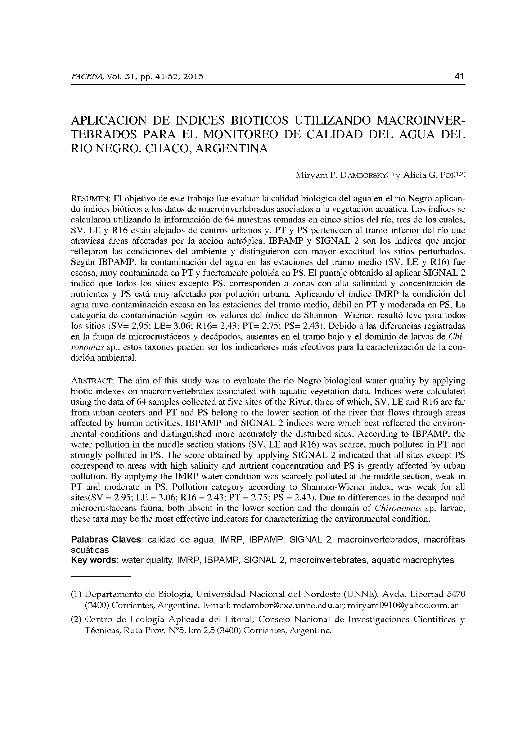Mostrar el registro sencillo del ítem
dc.contributor.author
Damborsky, Miryam Pieri

dc.contributor.author
Poi, Alicia Susana G.

dc.date.available
2023-01-03T17:59:47Z
dc.date.issued
2015-12
dc.identifier.citation
Damborsky, Miryam Pieri; Poi, Alicia Susana G.; Aplicación de índices bióticos utilizando macroinvertebrados para el monitoreo de calidad del agua del Rio Negro, Chaco, Argentina; Universidad Nacional del Nordeste. Facultad de Ciencias Exactas y Naturales y Agrimensura; Facena; 31; 12-2015; 41-52
dc.identifier.issn
0325-4216
dc.identifier.uri
http://hdl.handle.net/11336/183210
dc.description.abstract
El objetivo de este trabajo fue evaluar la calidad biológica del agua en el río Negro aplicando índices bióticos a los datos de macroinvertebrados asociados a la vegetación acuática. Los índices se calcularon utilizando la infor1nación de 64 n1uestras tomadas en cinco sitios del río, tres de los cuales, SV, LE y Rl6 están alejados de centros urbanos y, PT y PS pertenecen al tramo inferior del río que atraviesa áreas afectadas por la acción antrópica. IBPM1P y SIGNAL 2 son los índices que n1ejor reflejaron las condiciones del ambiente y distinguieron con mayor exactitud los sitios perturbados. Según IBPAJVlP, la contmninación del agua en las estaciones del trmno n1edio (SV, LE y Rl6) fue escasa, n1uy contmninada en PT y fuertemente poluída en PS. El puntaje obtenido al aplicar SIGNAL 2 indicó que todos los sitios excepto PS, corresponden a zonas con alta salinidad y concentración de nutrientes y PS está muy afectado por polución urbana. Aplicando el índice IMRP la condición del agua tuvo conta111inación escasa en las estaciones del tramo 1nedio, débil en PT y moderada en PS. La categoría de contmninación según los valores del índice de Shannon- Wiener, resultó leve para todos los sitios (SV= 2,95; LE= 3,06; Rl6= 2,43; PT= 2,75; PS= 2,43). Debido a las diferencias registradas en la fauna de microcrustáceos y decápodos, ausentes en el tramo bajo y el dominio de larvas de Chirono1nus sp., estos taxones pueden ser los indicadores 1nás efectivos para la caracterización de la condición ambiental.
dc.description.abstract
The ai111 of this study was to evaluate the rio Negro biological water quality by applying biotic indexes on 1nacroinvertebrates associated with aquatic vegetation data. Indices were calculated using the data of 64 samples collected at five sites of the River, three of which, SV, LE and R 16 are far fro1n urban centers and PT and PS belong to the lower section of the river that flows through areas affected by hu1nan activities. IBPAMP and SIGNAL 2 indices were which best reflected the environn1ental conditions and distinguished more accurately the disturbed sites. According to IBPAMP, the water pollution in the middle section stations (SV, LE and Rl6) was scarce, nluch polluted in PT and strongly polluted in PS. The score obtained by applying SIGNAL 2 indicated that all sites except PS correspond to area<:; with high salinity and nutrient concentration and PS is greatly affected by urban pollution. By applying the IMRP water condition was scarcely polluted at the middle section, weak in PT and moderate in PS. Pollution category according to Shannon-Wiener index, wa<:; weal<. for all sites(SV = 2.95; LE= 3.06; Rl6 = 2.43; PT = 2.75; PS = 2.43). Dueto differences in the decapod and n1icrocrustaceans fauna, both absent in the lower section and the do1nain of Chironomus sp. larvae, these taxa may be the most effective indicators for characterizing the enviromnental condition.
dc.format
application/pdf
dc.language.iso
spa
dc.publisher
Universidad Nacional del Nordeste. Facultad de Ciencias Exactas y Naturales y Agrimensura

dc.rights
info:eu-repo/semantics/openAccess
dc.rights.uri
https://creativecommons.org/licenses/by-nc-sa/2.5/ar/
dc.subject
CALIDAD DE AGUA
dc.subject
IMRP
dc.subject
IBPAMP
dc.subject
SIGNAL 2
dc.subject
MACROINVERTEBRADOS
dc.subject
MACRÓFITAS ACUÁTICAS
dc.subject.classification
Ecología

dc.subject.classification
Ciencias Biológicas

dc.subject.classification
CIENCIAS NATURALES Y EXACTAS

dc.title
Aplicación de índices bióticos utilizando macroinvertebrados para el monitoreo de calidad del agua del Rio Negro, Chaco, Argentina
dc.type
info:eu-repo/semantics/article
dc.type
info:ar-repo/semantics/artículo
dc.type
info:eu-repo/semantics/publishedVersion
dc.date.updated
2023-01-03T14:29:08Z
dc.journal.volume
31
dc.journal.pagination
41-52
dc.journal.pais
Argentina

dc.journal.ciudad
Corrientes
dc.description.fil
Fil: Damborsky, Miryam Pieri. Universidad Nacional del Nordeste. Facultad de Ciencias Exactas, Naturales y Agrimensura. Departamento de Biología; Argentina
dc.description.fil
Fil: Poi, Alicia Susana G.. Consejo Nacional de Investigaciones Científicas y Técnicas. Centro Científico Tecnológico Conicet - Nordeste. Centro de Ecología Aplicada del Litoral. Universidad Nacional del Nordeste. Centro de Ecología Aplicada del Litoral; Argentina. Universidad Nacional del Nordeste. Facultad de Ciencias Exactas, Naturales y Agrimensura. Departamento de Biología; Argentina
dc.journal.title
Facena

dc.relation.alternativeid
info:eu-repo/semantics/altIdentifier/url/https://revistas.unne.edu.ar/index.php/fce/article/view/650
dc.relation.alternativeid
info:eu-repo/semantics/altIdentifier/doi/http://dx.doi.org/10.30972/fac.310650
Archivos asociados
